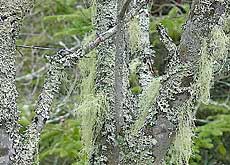
Lichens and dragonflies face uncertain future

Nearly 40 per cent of lichens and dragonflies in Switzerland are threatened with extinction or have already disappeared.
The Swiss environment agency says man is largely to blame for the losses, with industry, transport and leisure activities the principal culprits.
Dragonflies and lichens have joined some 3,000 other plants and animals on the agency’s national list of endangered species.
There are believed to be more than 2,000 species of lichen in Switzerland.
From surveys carried out across the country, the agency has determined that 44 per cent of lichens growing on trees and 24 per cent of those on rocks, soil and roofs are threatened.
Dragonflies have not fared much better, with 36 per cent in decline or extinct.
“These figures do not even give the complete picture,” Francis Cordillot of the environment agency told swissinfo.
“If we don’t do something, half the lichens and dragonflies of Switzerland will disappear.”
Under threat
Lichens are particularly threatened in alpine, agricultural and urban areas. The agency said forestry and agriculture should take more account of the natural environment.
Lichens are a successful alliance between a fungus and an alga, living together and functioning as a single organism.
Many lichens show a remarkable sensitivity to air quality and can be used to monitor air pollution.
They are also useful as food, medicine, for making dyes, in perfume manufacture, as decorations and in science.
Endangered species
“We have detected a high percentage of species threatened in Switzerland. One of the main reasons is air pollution and the other is habitat destruction,” said Christoph Scheidegger of the Federal Institute for Forest, Snow and Landscape Research.
“We have to keep the air clean, and rare habitats have to be protected in the future.”
Besides certain rare species of dragonfly, three common ones have also declined in numbers since the first “Red List” of endangered species was drawn up in 1994.
The destruction of natural habitat is believed to be the principal cause. The larvae of certain species need to spend up to three years in clean water before they can hatch.
Parallel to the decline of indigenous species, four new species of dragonfly, originally from the Mediterranean, have begun to thrive in Switzerland.
swissinfo
Nearly 40 per cent of lichens and dragonflies in Switzerland are endangered.
Alpine, agricultural and built-up areas are the worst affected.
Industrial and leisure activities as well as transport are to blame.

In compliance with the JTI standards
More: SWI swissinfo.ch certified by the Journalism Trust Initiative





























You can find an overview of ongoing debates with our journalists here . Please join us!
If you want to start a conversation about a topic raised in this article or want to report factual errors, email us at english@swissinfo.ch.